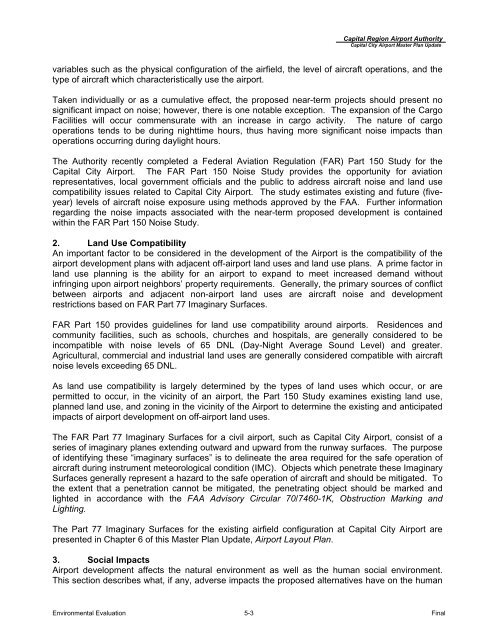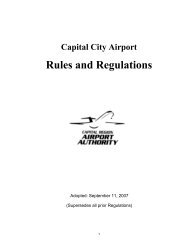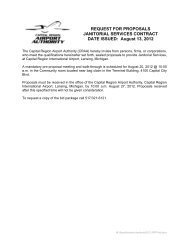Master Plan Update (pdf) - Lansing/Capital City Airport
Master Plan Update (pdf) - Lansing/Capital City Airport
Master Plan Update (pdf) - Lansing/Capital City Airport
Create successful ePaper yourself
Turn your PDF publications into a flip-book with our unique Google optimized e-Paper software.
<strong>Capital</strong> Region <strong>Airport</strong> Authority<br />
<strong>Capital</strong> <strong>City</strong> <strong>Airport</strong> <strong>Master</strong> <strong>Plan</strong> <strong>Update</strong><br />
variables such as the physical configuration of the airfield, the level of aircraft operations, and the<br />
type of aircraft which characteristically use the airport.<br />
Taken individually or as a cumulative effect, the proposed near-term projects should present no<br />
significant impact on noise; however, there is one notable exception. The expansion of the Cargo<br />
Facilities will occur commensurate with an increase in cargo activity. The nature of cargo<br />
operations tends to be during nighttime hours, thus having more significant noise impacts than<br />
operations occurring during daylight hours.<br />
The Authority recently completed a Federal Aviation Regulation (FAR) Part 150 Study for the<br />
<strong>Capital</strong> <strong>City</strong> <strong>Airport</strong>. The FAR Part 150 Noise Study provides the opportunity for aviation<br />
representatives, local government officials and the public to address aircraft noise and land use<br />
compatibility issues related to <strong>Capital</strong> <strong>City</strong> <strong>Airport</strong>. The study estimates existing and future (fiveyear)<br />
levels of aircraft noise exposure using methods approved by the FAA. Further information<br />
regarding the noise impacts associated with the near-term proposed development is contained<br />
within the FAR Part 150 Noise Study.<br />
2. Land Use Compatibility<br />
An important factor to be considered in the development of the <strong>Airport</strong> is the compatibility of the<br />
airport development plans with adjacent off-airport land uses and land use plans. A prime factor in<br />
land use planning is the ability for an airport to expand to meet increased demand without<br />
infringing upon airport neighbors’ property requirements. Generally, the primary sources of conflict<br />
between airports and adjacent non-airport land uses are aircraft noise and development<br />
restrictions based on FAR Part 77 Imaginary Surfaces.<br />
FAR Part 150 provides guidelines for land use compatibility around airports. Residences and<br />
community facilities, such as schools, churches and hospitals, are generally considered to be<br />
incompatible with noise levels of 65 DNL (Day-Night Average Sound Level) and greater.<br />
Agricultural, commercial and industrial land uses are generally considered compatible with aircraft<br />
noise levels exceeding 65 DNL.<br />
As land use compatibility is largely determined by the types of land uses which occur, or are<br />
permitted to occur, in the vicinity of an airport, the Part 150 Study examines existing land use,<br />
planned land use, and zoning in the vicinity of the <strong>Airport</strong> to determine the existing and anticipated<br />
impacts of airport development on off-airport land uses.<br />
The FAR Part 77 Imaginary Surfaces for a civil airport, such as <strong>Capital</strong> <strong>City</strong> <strong>Airport</strong>, consist of a<br />
series of imaginary planes extending outward and upward from the runway surfaces. The purpose<br />
of identifying these “imaginary surfaces” is to delineate the area required for the safe operation of<br />
aircraft during instrument meteorological condition (IMC). Objects which penetrate these Imaginary<br />
Surfaces generally represent a hazard to the safe operation of aircraft and should be mitigated. To<br />
the extent that a penetration cannot be mitigated, the penetrating object should be marked and<br />
lighted in accordance with the FAA Advisory Circular 70/7460-1K, Obstruction Marking and<br />
Lighting.<br />
The Part 77 Imaginary Surfaces for the existing airfield configuration at <strong>Capital</strong> <strong>City</strong> <strong>Airport</strong> are<br />
presented in Chapter 6 of this <strong>Master</strong> <strong>Plan</strong> <strong>Update</strong>, <strong>Airport</strong> Layout <strong>Plan</strong>.<br />
3. Social Impacts<br />
<strong>Airport</strong> development affects the natural environment as well as the human social environment.<br />
This section describes what, if any, adverse impacts the proposed alternatives have on the human<br />
Environmental Evaluation 5-3 Final




